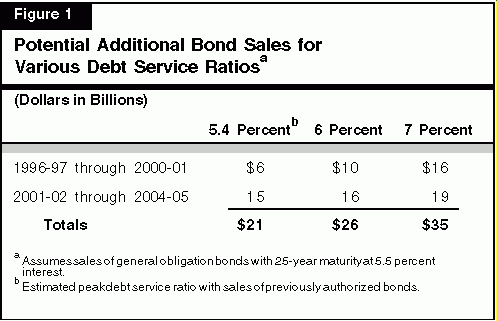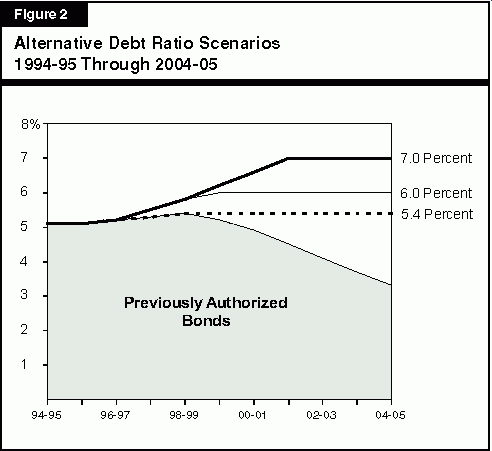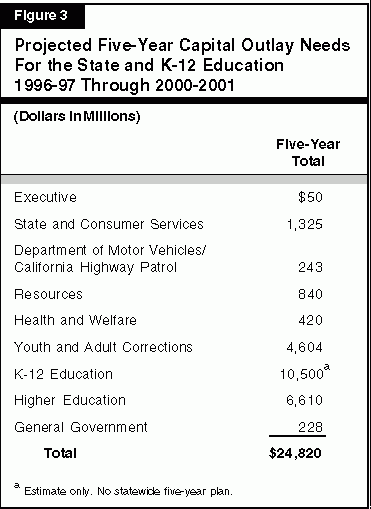Legislative Analyst's Office, May 20, 1996
 |
Bond Debt Update |
In the March 26 statewide election, the voters approved two
general obligation bond measures totaling $5 billion -- $3 billion for K-12
schools ($2.025 billion) and higher education facilities ($975 million) and
$2 billion to retrofit state highway bridges and toll bridges. This was the highest
level of bonds approved since the June 1990 primary election when six
measures totaling $5.1 billion received a majority vote. Between the June 1990
and March 1996 elections, the voters had approved only five of twenty
statewide bond measures ($4.9 billion of $15.5 billion proposed bonds).
This policy brief discusses the General Fund cost that will be incurred
from sales of these March 1996 bonds, as well as other previously
authorized bonds, and how these costs affect the state's ability to issue additional
debt to finance the state's capital outlay program.
Current and
Projected Debt Levels
The state's debt service costs in the current fiscal year are about
$2.3 billion, or about 5.1 percent of estimated General Fund revenues for 1995-96.
This percentage is referred to as the state's debt ratio. By this measure,
California's debt level is the twelfth highest among the states. There are currently
about $9 billion in authorized but unsold general obligation and
lease-payment bonds. We estimate that as these bonds are sold over the next several
years, the state's debt payments will increase to $2.9 billion in 1999-2000.
We estimate that the state's debt ratio will peak at 5.4 percent in 1998-99
and decline thereafter to 3.3 percent by the end of the period. (Actual debt
ratios will, of course, depend on the timing, volume, and actual interest rates
on bond sales, and on actual General Fund revenues.)
Future Bond Authorizations
Figure 1 shows the amount of additional general obligation
bonds that the state could sell through 2004-05 and remain within various debt
service levels. The various scenarios are illustrated in Figure 2. As the
figures show, a higher level of bonds can be sold in the second half of the
period. This is because, as debt is retired and debt payments decline for
previously authorized bonds, there is more
"room" to sell newly authorized bonds. Figure 1 is based on current law. If
the Governor's tax cut proposal is enacted, the range of bond sales over the
period shown in Figure 1 would be reduced by about $5 billion under each
debt level.

The data in Figure 1 are intended to illustrate the state's debt
capacity under different assumptions. We do not intend to imply that there is
a "right" level of debt which the Legislature should use as a control
on future authorizations. Instead, the Legislature should assess the
state's needs for all capital outlay programs, determine which programs
are priorities for bond funding over a multiyear period, and consider
the trade-off of using General Fund revenues to pay debt service
for improvement of capital assets versus funding other state programs.

Capital Outlay Needs
As summarized in Figure 3, state agencies and K-12 education
have identified the need for about $25 billion over the next five years to meet
their capital outlay needs. (This total does not include transportation programs, such
as highways and rail.) The $25 billion should be viewed with caution because some
of the agency plans are incomplete and also may include proposals that
upon examination would not merit funding. In addition, Figure 3 does not
include some local government capital outlay needs (such as jails and water
treatment facilities) for which the state has provided funds in past years.
In general, however, the $25 billion provides a reasonable assessment
of the overall magnitude of five-year capital outlay needs.

Limits on Meeting Capital Outlay
Needs. As shown in Figure 2, even if the state had a relatively high
debt ratio of 7 percent, it could sell only $16 billion in bonds over the next
five years. This level of funding would fall far short of the capital needs
during that period identified in Figure 3. Furthermore, our debt ratio
estimates are based on the use of general obligation bonds. To the extent
that more costly lease-payment bonds are used, fewer needs could be funded.
Conclusion
The state clearly has limitations on the level of future bonds that can
be authorized and sold to address its significant capital outlay needs. It
is therefore imperative that future authorizations be targeted to
the highest priority programs and projects.
We continue to stress that the Legislature must develop a comprehensive plan in order
to address the state's capital outlay program needs in the context
of limited fiscal resources. To develop such a plan, the Legislature
should undertake a comprehensive review of the state's capital outlay needs,
set priorities, and establish a financing plan to meet these priorities over
a multiyear period.
This Policy Brief was prepared by Chuck Nicol, under the supervision of
Gerald Beavers.
This reports and others are available on the LAO's World Wide Web page at http://www.lao.ca.gov.
The Legislative Analyst's Office is located at 925 L Street, Suite 1000, Sacramento, CA 95814.
To request publications call (916) 445-2375. |
Return to LAO Home Page




